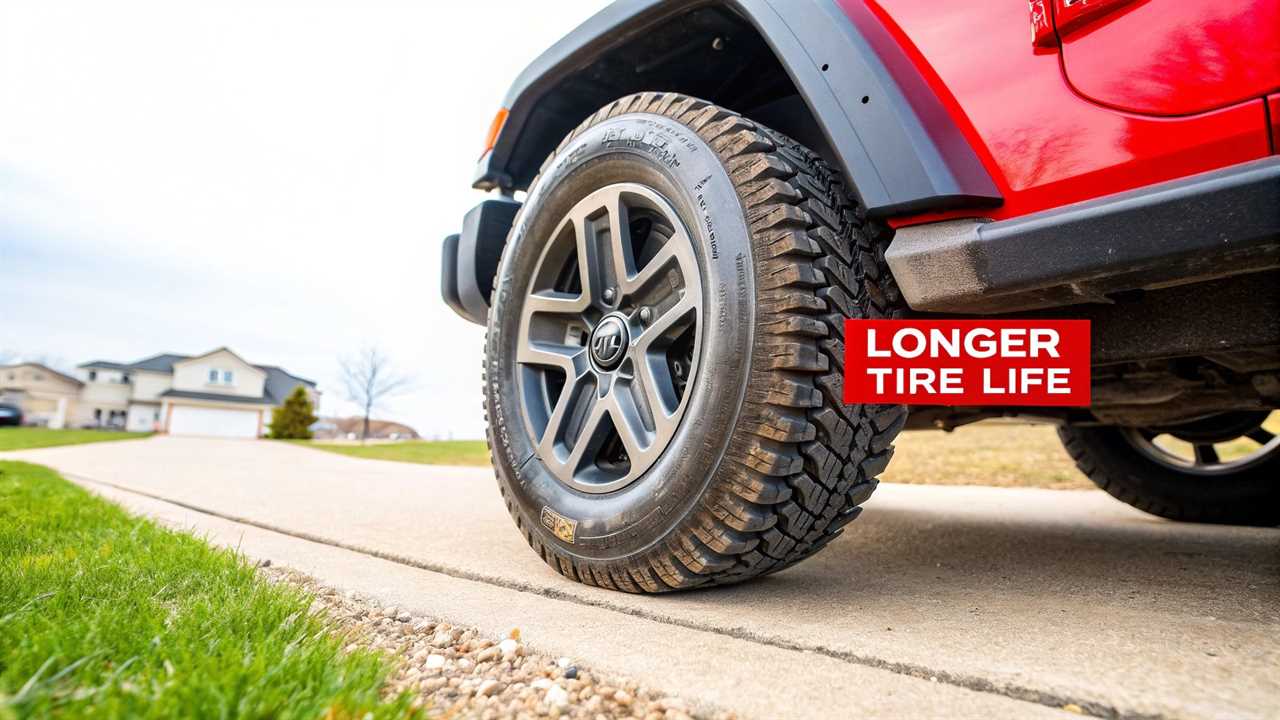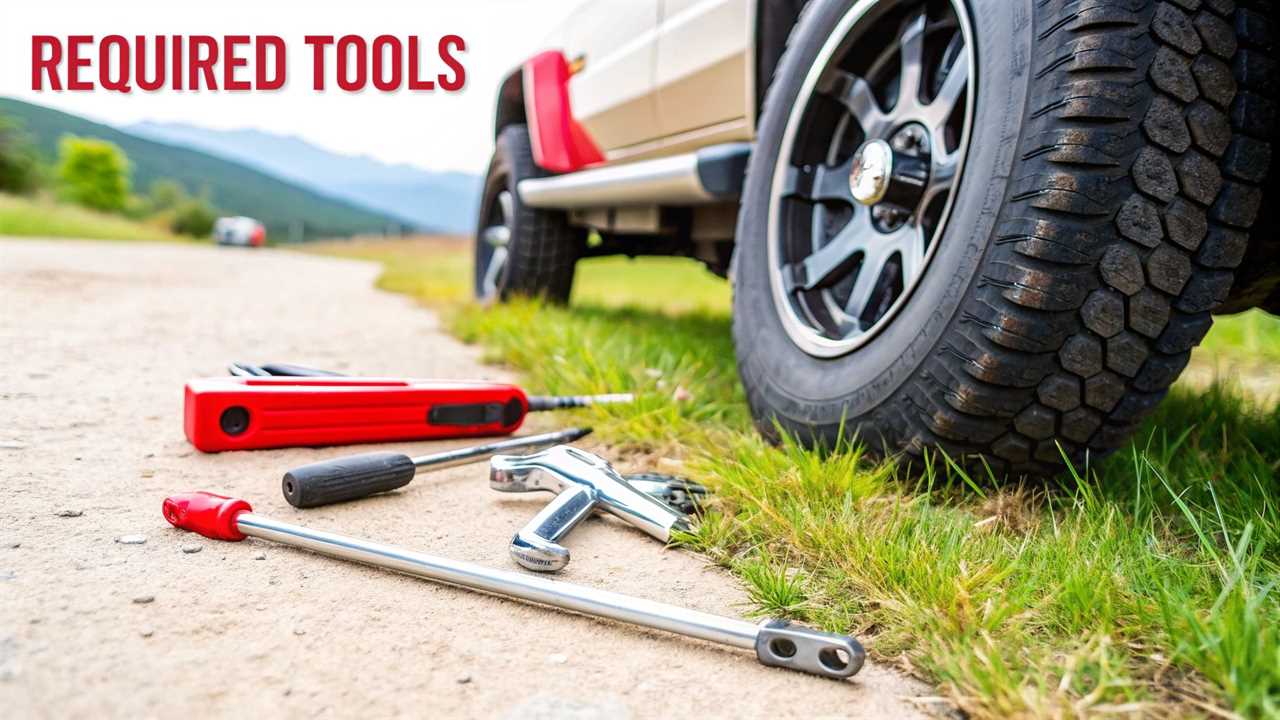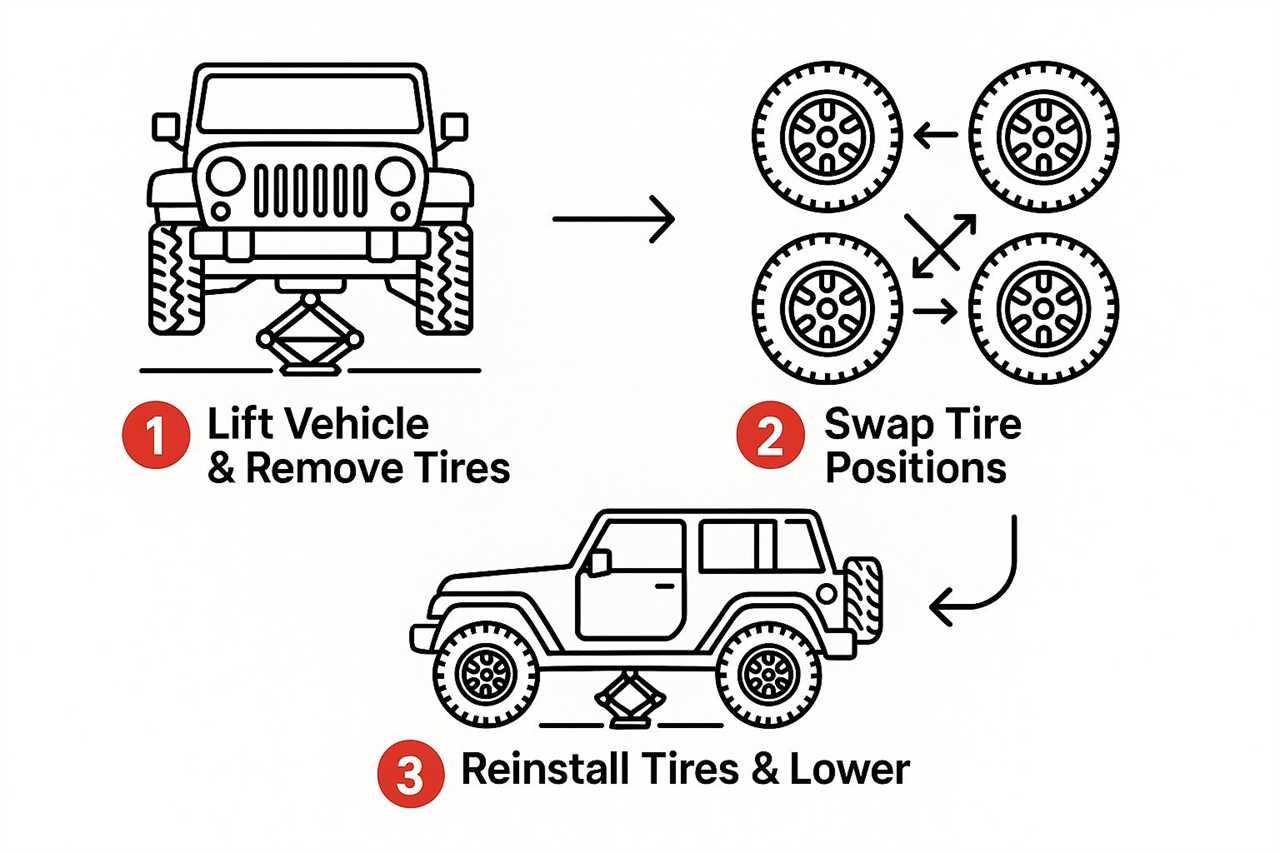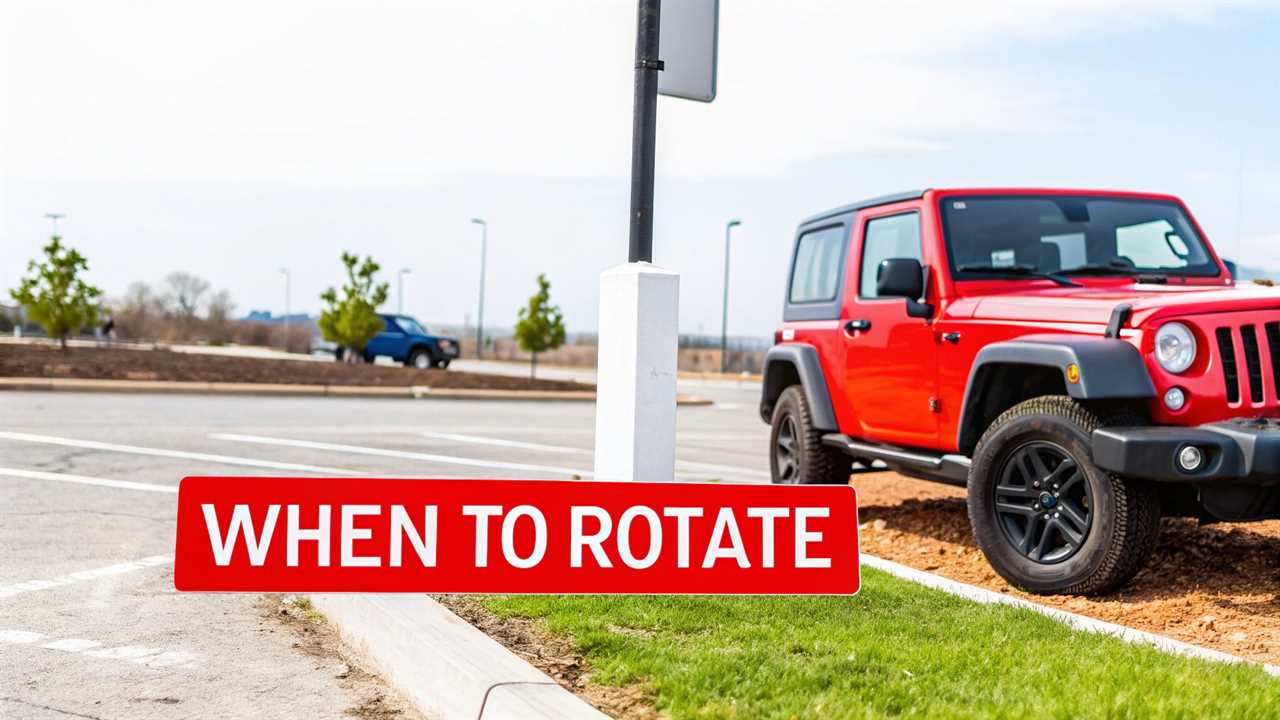A proper Jeep tire rotation is a critical maintenance task, not just a suggestion. It involves moving your tires to different positions on a set schedule. Due to a Jeep’s weight distribution and 4WD demands, front and rear tires wear at different rates.
Following a consistent schedule ensures balanced wear, improves safety, and saves you money.
Why Regular Jeep Tire Rotation Is So Important

Skipping tire rotations leads to uneven wear patterns like cupping and feathering. These issues shorten tire lifespan and can harm your Jeep’s handling and stability. Over time, uneven wear can cause much bigger problems.
Imbalanced tires can even contribute to the infamous “death wobble.” You can learn more in our guide on the Jeep death wobble and how to correct it. This process is even more crucial for Jeeps that see dirt, rocks, and mud.
Off-roading puts serious, unpredictable stress on tires, wearing them down faster than pavement driving.
Following a proper rotation schedule isn’t just about maintenance. It’s about preserving your Jeep’s legendary capability and protecting your investment.
The Real-World Impact of Tire Care
Tire care is gaining attention. In 2021, global replacement tire sales reached 107 million units, a 21.6% increase from the previous year. For Jeeps hitting trails, rotating tires every 5,000 to 7,500 miles can cut the risk of uneven wear by 25–30%.
Unfortunately, only about 60-70% of owners stick to that schedule. This often means buying new tires much sooner than necessary.
Jeep Tire Rotation Quick Guide
| Rotation Interval |
Primary Benefit |
Affected Component |
| 5,000–7,500 miles |
Extends tire lifespan and promotes even wear. |
Tires and Tread |
| Every 6 months |
Improves handling, stability, and traction. |
Suspension & Drivetrain |
| Follow manufacturer spec |
Prevents vibrations and potential alignment issues. |
Steering System |
This table shows how routine maintenance protects your entire vehicle, not just the rubber.
The benefits are clear, and understanding the cost of tire rotation shows how this small expense saves money long-term. Even wear maximizes tire lifespan and delays the need for a costly new set.
Choosing the Right Tools for the Job

Before lifting your Jeep, you need the right gear. This is not the time to cut corners. The flimsy scissor jack included with your Jeep is only for roadside emergencies.
For a full Jeep tire rotation, a heavy-duty floor jack and properly rated jack stands are non-negotiable. Your Jeep is heavy, so use tools designed to handle its weight safely. Always ensure your jack stands are rated for more than your Jeep’s weight.
The Wrench Matters
You also need a good wrench. A standard lug wrench can loosen nuts, but it can’t ensure they’re tightened correctly. That’s where a torque wrench is essential.
Using a torque wrench is the only way to tighten lug nuts to manufacturer specifications. This simple step prevents stripped threads, damaged brake rotors, or a wheel coming loose.
Over-tightening is as dangerous as under-tightening. A reliable torque wrench ensures every lug nut is perfect, protecting you and your Jeep.
Mastering The 5-Tire Rotation Pattern
If your Jeep has a full-size spare, a 5-tire rotation is the best method. Simply swapping front and back tires guarantees uneven wear over time. Including the spare ensures all five tires share the load and wear down at the same rate.
This isn’t just about getting more miles from your tires; it’s a major safety factor. A rotated spare has consistent tread depth with the other tires. If you get a flat, you can swap it in without creating a dangerous handling imbalance.
The Rearward Cross pattern is the best choice for any 4WD vehicle like a Jeep.

This image shows the basic process of safely lifting, swapping, and lowering the vehicle. Think of it as a cycle that keeps your tires healthy.
Common Jeep Tire Rotation Patterns Explained
Several tire rotation methods exist, and the right one depends on your vehicle. This table breaks down the most common patterns and their uses.
| Pattern Name |
Best For |
Includes Spare? |
| Rearward Cross |
4WD/AWD vehicles with a full-size spare. The standard for Jeeps. |
Yes |
| Forward Cross |
Front-wheel drive (FWD) vehicles, with or without a spare. |
Optional |
| X-Pattern |
FWD, RWD, or 4WD/AWD vehicles without directional tires. |
No |
| Rearward Straight |
Vehicles with different-sized front and rear tires (staggered setup). |
No |
The Rearward Cross is the best option for Jeeps. It’s designed for 4WD systems and a full-size spare.
How The Rearward Cross Works
Let’s walk through the Rearward Cross pattern. It might sound complex, but it follows a logical sequence. It will become second nature after you do it once.
Here is the move-by-move breakdown:
- The spare moves to the right rear position.
- The right rear tire moves to the right front.
- The right front tire crosses to the left rear.
- The left rear tire moves to the left front.
- The left front tire becomes the new spare.
This pattern gives every tire a turn at each corner and a rest period as the spare. It’s the best way to maximize the life of your entire set of tires. This is especially important for expensive all-terrain or mud-terrain tires.
Choosing the right rubber is also critical. If you need a new set, our guide on how to choose all-terrain tires for your truck can help.
This effort pays off. Unrotated tires can lose 4/32″ of tread in just 15,000 miles. A proper rotation can also improve fuel economy by 1–2%.
The global tire market is projected to hit $192 billion by 2031, showing that proper maintenance is vital. You can find more on these tire industry trends on PR Newswire.
How to Safely Rotate Your Jeep’s Tires
With your tools ready and pattern chosen, it’s time to work. The number one rule is safety first. Never attempt a Jeep tire rotation on a sloped or soft surface.
You need a flat, level, and solid surface, like a garage floor.
Before touching the jack, use wheel chocks. If you start with the front end, wedge chocks firmly behind both rear tires. This simple step prevents your Jeep from rolling while it’s in the air.
A pro-mechanic trick is to “break” the lug nuts loose while the Jeep is on the ground. Don’t remove them, just give them a half-turn. This uses the vehicle’s weight to stop the wheel from spinning, saving you frustration.
Proper Lifting and Support
Now, it’s time to lift the Jeep. You must find the correct jacking points on the frame. Guessing can cause serious, expensive damage to your vehicle.
Your owner’s manual shows the reinforced sections of the frame rail or axle tubes.
Once the Jeep is jacked high enough, immediately slide your jack stands into place. They go under the designated support points shown in your manual.
Never get under a vehicle supported only by a jack. Jacks are for lifting, not supporting, and can fail without warning. Jack stands are non-negotiable safety equipment designed to hold your rig’s full weight.
Slowly lower the jack until the Jeep’s weight rests on the stands. Gently shake it to ensure stability. Now you can safely unscrew the lug nuts and swap your tires using the 5-tire rotation pattern.
Insider Tips And Common Mistakes To Avoid

Getting the wheels back on is a great feeling, but you’re not done. The physical Jeep tire rotation is only part of the job. A few extra steps will ensure the job is done right and keep you safe.
First, grab your tire pressure gauge. Check and adjust the pressure on all five tires, including the one from the spare carrier. Set them all to the recommended PSI on the sticker inside your driver’s door jamb.
This simple step ensures predictable handling and even wear.
The Critical 100-Mile Checkup
This step is often skipped but is one of the most important. After driving for about 50-100 miles, you must re-torque the lug nuts. The wheels can settle against the hub, which may slightly loosen the lug nuts.
This check only takes a few minutes but is a massive safety precaution.
Don’t skip this re-torque. A loose wheel is one of the most dangerous mechanical failures you can experience.
While the tires are off, it’s the perfect time for a quick visual inspection. Look at the tread and sidewalls for uneven wear, punctures, or cracking. Catching problems early can save you from a major headache or blowout on the trail.
If you spot serious wear, it might be time for a new set. Our guide on the 5 toughest snow tires for a Jeep Wrangler can help you find durable options.
Your Jeep Tire Rotation Questions Answered
It’s normal to have a few questions after a guide. Here are some of the most common questions from Jeep owners. These are quick, straightforward answers based on real-world experience.
How Often Should I Rotate My Jeep’s Tires?
For most daily driving, the standard of every 5,000 to 7,500 miles is a solid rule. It’s a common recommendation that works well for balancing tire life.
However, if you use your Jeep for off-roading, towing, or hauling, you need to be more aggressive. The extra strain causes more uneven wear. I recommend a rotation every 3,000 to 5,000 miles if you frequently go off-pavement.
What Is the Correct Lug Nut Torque for My Jeep?
You don’t want to guess on this one. The exact spec depends on your Jeep’s model and year. Your owner’s manual is always the most accurate source for this information.
As a general guide, most modern Wranglers and Gladiators fall in the 95 to 130 ft-lbs range. Always use a calibrated torque wrench to hit the exact number. This is critical for safety and preventing warped rotors.
Doing this yourself is rewarding, but there’s no shame in calling the pros. If you run into issues or lack time, professional tyre services are a great backup plan.
For more expert guides, gear reviews, and tutorials to help you conquer any terrain, visit Offroading.com and get prepared for your next adventure. Check out more at https://www.offroading.com.
https://offroading.com/jeep-tire-rotation/?utm_source=rss&utm_medium=rss&utm_campaign=jeep-tire-rotation
Did you miss our previous article...
https://manstuffnews.com/4x4-off-road-cars/your-ultimate-overlanding-packing-list-for-2025-7-resources
 Backyard GrillingWeekend WarriorsAdvice from DadBeard GroomingTV Shows for Guys4x4 Off-Road CarsMens FashionSports NewsAncient Archeology World NewsPrivacy PolicyTerms And Conditions
Backyard GrillingWeekend WarriorsAdvice from DadBeard GroomingTV Shows for Guys4x4 Off-Road CarsMens FashionSports NewsAncient Archeology World NewsPrivacy PolicyTerms And Conditions
